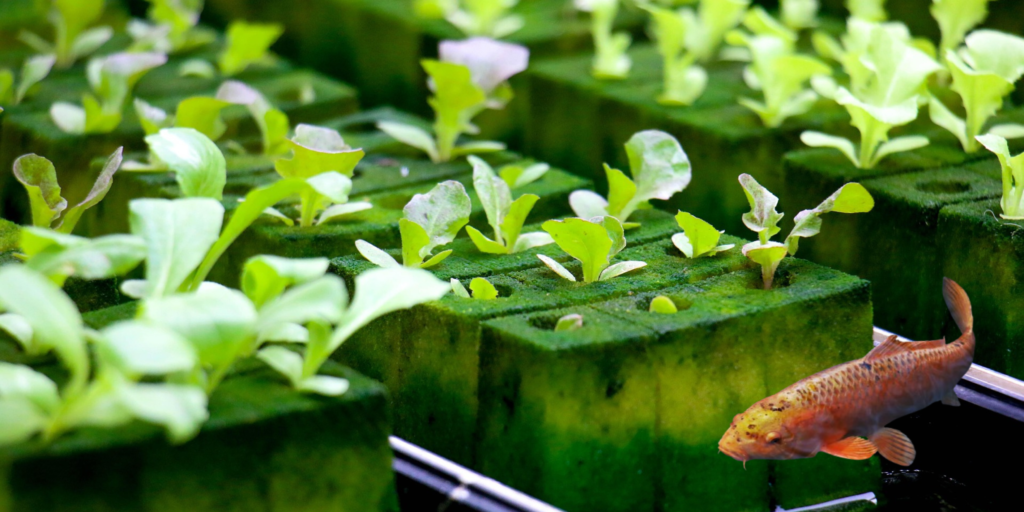An aquaponic garden is a sustainable agricultural system that integrates aquaculture (raising fish) with hydroponics (cultivating plant life without soil) into a unified ecosystem. This type of gardening involves plants being fed by nutrient-filled water from fish tanks, while the plants cleanse the water for the fish they house. Aquaponics are fantastic plants to grow at home, providing organic vegetables, herbs and even fruits in an eco-friendly self-sustainable environment. So, here we will look at how aquaponic gardening works, what it offers you, and how you can create an aquaponic system yourself, at home.

What is Aquaponic Gardening?
Aquaponics is a closed-loop system in which fish waste supplies organic nutrients to the plants, and the plants filter and purify the water before it is pumped back to the fish tank. Being a natural cycle, it allows one to avoid synthetic fertilizers and use a fraction of the water, making it an extremely efficient and eco-friendly way to garden.
Aquaponics is a cultivation method that combines aquaculture and hydroponics.
- Fish Tank – The fish are housed here which provides nutrient-rich water for the plants.
- Grow Bed – Where plants are grown, usually containing something like clay pellets as the growing medium.
- Water Pump – Moves water between the fish tank and the grow bed.
- Biofilter– Turns fish waste into plant nutrients
- Aeration System — for providing oxygen to fish and plant roots for healthy growth.
Advantages of Practicing Aquaponics Gardening
Sustainable and Eco-Friendly
- Aquaponics is a closed system that recycles water and nutrients, minimizing the environmental impact, and eliminating the need for chemical fertilizers.
- No Soil, No Weeds, No Pests
- Because plants are raised without soil, no weedings are needed, soil-borne pests and diseases are negligible.
Water-Efficient System
- With aquaponics, up to 90% less water is used than in traditional gardening, as the water is constantly recycled in the closed-loop system.
- Free of Chemicals and Organic Produce
- Because the system utilizes fish waste as a natural fertilizer, no pesticides or artificial fertilizers are needed.
Dual Harvest: Fish and Plants
- Besides growing fresh vegetables, aquaponics grow fish, making a sustainable farm for the food production cycle.
- Year-Round Gardening
- Aquaponics allows you to grow fresh food year-round with an indoor or greenhouse setup.
Build Your Own Aquaponic Garden System at Home
Step 1: Select Your Aquaponic System
A media-based aquaponic system (employing a grow bed with a growing medium) is one of the easiest and most efficient methods to begin with when it comes to home gardening.
Step 2: Gathering Materials
Here is what you need to create a DIY Aquaponic System:
- A fish tank (size is determined by space available and how many fish you want to have)
- Grow bed (for holding the plants in a shallow container)
- Water pump (to move water between fish tank and grow bed)
- Growing medium (clay pellets, gravel, or similar for plant support)
- Aquarium air pump and air stone (to oxygenate water for the fish and plants) (Most people use fish — tilapia, goldfish, or catfish.)
- Seeds or seedlings (leafy greens, herbs, and fruiting plants)
- Biological filtration medium (like the beneficial bacteria that turn fish poop into fertilizer for your plants)
Step 3: Setting Up the System
- Set up the Fish Tank – Fill the tank with water and let it go through a few days of cycling before adding fish.
- Install Water Pump — Drop the pump inside the fish tank and connect the pump to the grow bed.
- Start the Grow Bed – Populate the grow bed with growing medium and place it above the fish tank.
- Add the Biofilter – Add good bacteria to help turn fish muck into food
- Sow the Seeds or Seedlings – Set plants within the grow bed with roots deep enough to receive sufficient water.
- Add the Fish – Once the water has stabilized, you can add fish to the tank.
- Monitor pH and Nutrient Levels – Keeping a pH between 6.5 to 7.5 will keep your plants and fish thriving.
- Make Sure They Can Breathe – Keep the air pump working so the fish and plants get oxygen.
Step 4: Correct Maintenance of Your Aquaponic Garden
- Provide high-quality fish food to feed the fish on a regular basis.
- Check water quality and change water regularly when required.
- Look for any diseased leaves and remove them.
- Keep in mind that for the water to get properly circulated and nutrients to reach the roots, the pump and filters need to be working properly.
Best Plants for Aquaponic Gardening at Home
Here are some examples of crops that work well with aquaponic systems:
- Leafy Greens: Lettuce, spinach, kale, Swiss chard.
- Herbs: Basil, mint, parsley and cilantro.
- Fruiting Vegetables: Tomatoes, cucumbers, peppers and strawberries.
- Legumes: These include peas and beans, which fix nitrogen in the system.
Common Aquaponic Problems and Solutions
Cloudy or Dirty Water
Cause: Too much fish waste, uneaten food or algae growth. Solution: Feed fish less, clean tank & add more filter bacteria.
Poor Plant Growth
Explanatory: Nutrients insufficient, wrong pH, or low oxygen. Fix: Adjust pH levels, add more fish or beneficial bacteria, and make sure of aeration.
Fish Health Problems
Cause: Low levels of oxygen, bad water quality, or crowding. Solution: Aeration, clean water, and reducing fish population if needed.
Conclusion
It’s an innovative, sustainable and efficient way to grow healthy food at home aquaponic gardening. DIY Aquaponics System: This Will Keep You Equipped With Organic Vegetables and Fish Forever with Less Water Waste It Limits Environmental Impact Aquaponics is an excellent solution for sustainable home-based nutrition, whether you are novice or experienced in gardening. When you create your aquaponic garden today, you are able to enjoy these benefits of a self-sustaining food system!
